Arequipa Overview
"The White City"
Acknowledged as second most important City in Peru, Arequipa is distinguished as much for its handsome architectures and delicious food as for its eternally blue sky. No only does this City leave an indelible mark on all the one come to it but, besides, it sits at the foot of impressive Misti volcano, a true monument of nature.
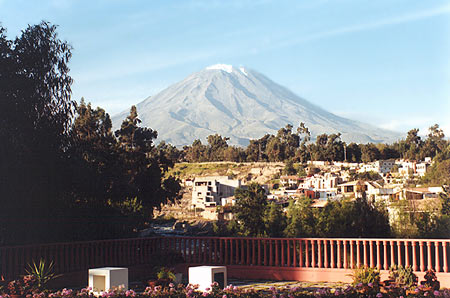
The city (2304m) is surrounded by 3 volcanoes; El Misti, still active at 5822m, the higher and extinct Chachani 6075m and Pichu Pichu 5571m. The Incas highly respected these volcanoes since the melt water from their snow-capped peaks form the headwaters of the mighty Amazon River, thousands of kilometers away.
"La Ciudad Blanca" (The White City), called so because of its buildings made of white petrified volcanic ash thrown up by Chancani volcano, is an example of a mix of Italian, Spanish and Andean styles. This power of attraction is summed up in the Quechua phrase "ari, que pay" (yes, stay!), the answer Inca Mayta Capac gave to his warriors when they asked him to let them make a halt in this lovely land.
Years later, on August 15, 1540, the Spanish founding would take place. Manuel Garcia de Carbajal baptized it, in the name of the Queen of Spain, as Villa de Nuestra Senora de la Asuncion del Valle Hermoso de Arequipa, since then it has acquired many characteristics that set it apart from the rest of Peruvian cities.
Plaza de Armas: Arequipa's Plaza de Armas is one of the most beautiful in Peru. The Plaza is surrounded on its other 3 sides by colonial arcaded buildings with many cafes and restaurants. Behind the Cathedral is a pretty back street with many handicraft shops.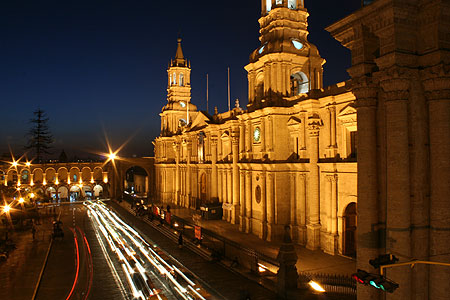
The Cathedral: On the north side of the Plaza de Armas is the impressive, twin-towered Cathedral, founded in 1612. The ancient cathedral was destroyed by the fire in 1844 and in two years was restored in a Renaissance style with French influence by from Arequipa Lucas Poblete. The facade occupies one side of the main square and exhibits two bronze medallions, symbols of the peru confederation. It has three large portals and holds a high altar of Italian Carrara marble made by Felippo Moratilla, a pulpit carved in wood by the French artist Rigot, and an organ made in Belgium.
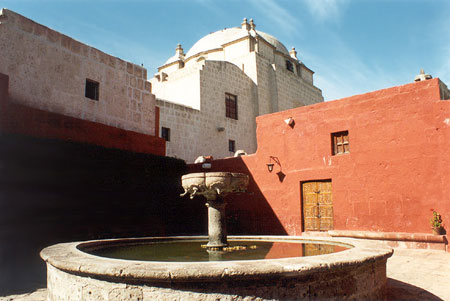
Santa Catalina Convent: The Monasterio de Santa Catalina is the most astonishing site in Arequipa. It was opened to the public in 1970 after 400 years as a cloister. The convent has been beautifully refurbished with period furniture and paintings. Behind the closed doors the nuns, daughters of aristocrats, paid little heed to the vows of poverty and silence. Each had her own servant and dined with porcelain plates, fine tablecloths and silver cutlery.
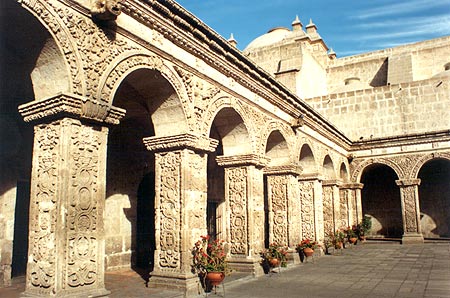
Church and Cloister of the Company: From the XVII century possessing a plateresque style facade, Baroque style gold leaf altars and pulpit. The sacristy is decorated with polychrome paintings of animal and plant shapes and with Cusco and Bitti School canvases. The Jesuit Cloisters display a Baroque-Mestizo (half-breed) style with three patios. The entire building is made of ashlar stone.
Home of the Blackberry Bush: Owes its name to a blackberry tree that is found in its patio. It is the prototype of the XVII century manor displaying its beautiful mestizo portal inlaid in ashlar stone, today it is the seat of the Banco Industrial.
Goyeneche Palace: There are three: two in the country (Huasacache and Sachaca) and the other in the city on 201 La Merced Street. Today it is the seat of the Banco de Reserva.
Cayma: 3 km from the center of the City called "Arequipa's Balcony" due to its view of the whole city. A Baroque-Mestizo church (1730) is found here. The Festivity of the Candelaria Virgin is traditional here (February 2).
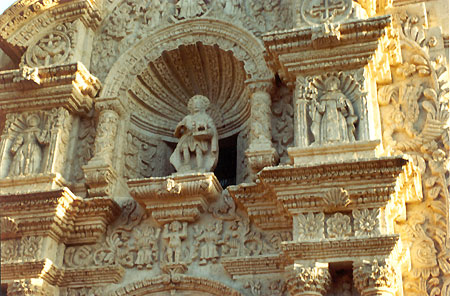
Yanahuara: 2 km from the center of the City. A legendary villa close (to the City with narrows) small streets and old homes with family orchards. Its 1750 built church is famous. It is located in the main square and has a Baroque facade and a frugal interior. The Yanahuara Observatory is an esplanade with ashlar stone archways.
Socobaya: 10 km from Arequipa, beautiful scenery, a paradise for poets and writers. Here the visitor finds natural caves (Las Penas) in the form of drains that distill water.
Chilina: Area with romantic scenery located on the length of the Cili river. It is the most beautiful area of the Arequipa countryside. The Molino Blanco (white mill). Former mill of St. Catalina is also located here.
Dead Bull Ancient Engraved Stones: Located in the Majes valley in an area of 5 km extended between 400 and 800 meters above sea level. It is probably the world's richest area in rupestrian art. It has more than 6,000 blocks of stone engraved in low relief of approximately 1,200 years of antiquity.
The Colca Canyon: Located in the province of Cailloma in Cabanaconde. Two or three days are recommending for a visit staying overnight in Achoma. The trip toward the Canyon is extremely interesting due not only to its scenic beauty but also to what it presents along the way: Evidence of the agricultural predominance of the ancient Peruvian culture, the large number of platforms, colonial architectonic monuments in picturesque towns, flora (variety of cactuses), and fauna (auquenidos, birds, condors). The Canyon has more than 100 km length, and its deepening (the deepest point being 3,400 meters) starts km after Chivay. The best observatory is 3,800 meters above sea level. The Colca Region is highly appropriate for adventure tourism.
Majes Valley: Located between 200 an 800 meters above sea level; fertile valley with warm climate year round because it is connected to a valley that is a continuation of the Colca. Upon their arrival the Spaniards were impressed with this canyon, and they baptized it as the Mages-tuoso (Majesty) Valley; this, the name, Majes. The main activities of its inhabitants are agriculture and shrimp fishing. The most common sports are canoeing and delta wing flying. The entire valley has a longitude of 80 km, and along the way one finds stone carvings, Pre-Inca cemeteries, rupestrian paintings, etc.
Valley of the Volcanoes: 377 km from Arequipa in Andagua in the province of Condesuyos behind the snowy peak of "Coropuna" located at an altitude of 3,450 meters above sea level with perpetual snow The visitor can enjoy a large quantity of fauna and natural scenery. There are 60 adjacent volcanoes, 30 of which posses a fissure with vegetation on their peaks.
Artisanship: The Arequipa Artisan work is well known for its excellent finish in rugs, in plate candlesticks, trays, iron lanterns, chess games, necklaces, bracelets, leather buttons, cigar cases, trunks, tables and ashlar stone decorations, flowerports, lamp stands, decorative bronze plates, silverwork, embroidered baize chests guitars, mandolins, charangos, (small chord instrument used by natives), saddles, shawis, sweaters, and spun alpaca ponchos. The material used are ashlarstone, forged iron, leather, textiles, and wood.